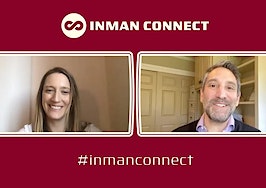From online showings to all-digital signings and closings, the digital transaction has fully come into its own. All month, Inman examines the companies and technologies driving this new world of digital transaction.
The leader in producing digital home tour content announced it will become a public company. Matterport, the “Xerox” and “Velcro” of immersive, web-based home tours, grew its subscriber base by 500 percent through 2020 because of the developed world’s need to see homes from a distance.
The company states it has the insides of millions of buildings in more than 150 countries prepared to be viewed online. The digital home showing isn’t coming. It’s here — and we’re already in its vortex.
Camera sophistication, bandwidth expansion, the mainstreaming of videoconferencing and consumer demand were all speeding toward one another long before the pandemic introduced an accelerant to the fuel mixture. But few probably guessed we’d be this far down the road.
Multiple listing services and major search portals, the national foundation of home search, have adapted to digitized home tours by providing tools and establishing best practices. Consumers are more than ready — in fact, they expect — to see a listing video before touring in person.
The ever-resilient real estate industry created its own technological antibodies to fight what COVID-19 did to the industry’s dependence on in-person information exchange.
Assisted by a service provider marketplace, rich with reactionary business acumen and sharply in focus on the agents’ needs and consumer wants, the collective real estate industry has made walking into homes via web browsers normal. Rare is the business use case for “pivot” not cliché, but here, it’s keenly on target.
This handbook is about helping readers understand why they’re effective and when they should be leveraged. We hope you take away a few options and tips for creating them, some pointers on coordinating with your clients and the subtle differences in how video is used to show property on a personal level compared to its use in general marketing.
Table of Contents
When and why
Although protecting the health of everyone involved in a showing makes the most reasonable argument for creating a digital showing, it’s not the only reason you would produce one.
Offering aspiring buyers a way to preview a home before they see it in person can demonstrate to sellers that you value their time. As motivated as your sellers say they are, their actions after a day of multiple walkthroughs and constant home-cleaning often suggest otherwise.
Let’s face it: Living in a house that has to be impeccably maintained to satisfy an ever-critical buying public is a challenging emotional hurdle. Even if the house is staged, the effort to ensure it’s always show-ready gets old quick.
Listing agents could start leveraging digital showings as way to further test buyers’ interest by requiring them to be viewed before an in-person tour is scheduled. A simple acknowledgement form sent from listing agent to the buyer representative upon making the in-person appointment could at least let the seller know there’s more than surface-level interest. No one appreciates their time being wasted.
However, what if a home is the opposite of staged? What if you’re selling a place that’s vacant — a situation that’s more challenging than it seems, as countless studies show that furniture and a sense of “being lived in” helps buyers envision themselves as a part of that home.
Virtual staging can be a tremendous resource for marketing a home for showing online. Flat, empty rooms simply don’t photograph well. A lack of furniture makes room scale hard to judge and invites vagaries about layout and décor. Virtual staging can solve those issues, as well as make a home look more inviting, modern and family-oriented.
Tom Woolrich, associate broker at Hub Real Estate, said in the Inman Coast-to-Coast Facebook group that staging is critical. “I don’t think I’ve ever written an offer on an empty home,” he said. “If you have a blank slate to work with, it’s worth your time to hire a staging expert.”
Virtual staging and online showings are especially beneficial in the luxury market. At Luxury Connect back in 2019, Dusty Baker, a Southern California-based agent at Sotheby’s International Realty, said that he’s leveraging video as often as possible.
Technology is also making staging less disruptive via augmented and virtual reality, according to Baker. He pointed out that a home can be partly or entirely staged digitally, which is a major boon to consumers.
“I try to stage every single one,” he said. He admitted to being “pessimistic” about how many people actually watch real estate marketing videos, but they matter because platforms such as Zillow and Google actually prioritize listings with video. Thus, another reason to consider digital showings? SEO clout.
Digital showings are valuable tools for listing agents. Sellers want to know that their home is going to be exposed to as much of the market as frequently as possible. There’s likely no better way than recording and marketing a video tour, which opens the home to every possible match 24/7.
On that note, virtual showings provide reticent sellers with a terrific alternative to in-person open houses.
Some home-tour software products enable agents to present recorded tours as live events, scheduled once or twice a week just as you would market a traditional open house. They can also highlight home features with interactive hotspots, include live chat and offer 3D pan controls to multiple users.
What’s more, as with a traditional open house, lead information can be captured and plugged into a customer relationship management (CRM) solution.
The capability of listing agents to produce digital video content will demonstrate technical savvy and certainly help you stand out from those who don’t. Digital showings can be produced in a number of styles, from informational “walk and talks” to creative and lifestyle-driven formats.
It’s also worth noting that today’s buyers are often not in the process by themselves. Partners, parents and friends are often exerting influence over the person whose name will end up on the deed. There’s no shortage of buyer agents who can attest to having to arrange multiple showings so a buyer can have a trusted cohort offer feedback on the primary bathroom’s paint scheme or square footage of closet space. This is convenient for no one.
Digital showings can remedy the multiple-party visit problem. Listing agents, or even the sellers, are more than capable of using video to share specific home details.
In general, know that the industry as a whole is also adapting to the surge in digital transaction processes of which the home showing is certainly a critical part.
CRM and marketing software providers are including features that integrate and promote their users’ virtual showings. Chime and PureAgent CRM smartly integrate with Facebook Live to promote digital showings.
Companies are emerging with software products that have digitized the listing presentation, the CMA and even commission checks. So, as the entire transaction merges into the ones and zeros of the web, why shouldn’t the home tour?
Technological advancements have made creating digital video content very easy. Even if an agent chooses not to use any number of available software products, a smartphone and a sub-$150 stabilizer can do the trick in little time.
“The time has gone for politely suggesting that as agents you probably should be creating digital tours,” Peter Schravemade of real estate visual marketing company BoxBrownie said in an email to Inman. “The overwhelming evidence is that you should be creating tours; The technology is over two decades old, we are still amidst a serious health global event stopping purchasers [from] getting to homes, the cost of creating a tour is no longer prohibitive, and most importantly, purchasers of all generations are telling you it is important to their experience in buying the home.”

Additional resources:
- Interactive Virtual Tours’ floor plan product faces a tough field of competitors: Tech Review
- The Inman Handbook on how to sell a home without setting foot in it
- Inman Handbook on creating online home tours
- What’s the status of remote closings across the US?
- How to choose the right virtual tour provider for you
Working with sellers
As much as sellers want fast and clean sales, their willingness to openly accept what their agent suggests doesn’t always reflect that sentiment. List price, marketing strategy, negotiation, fixtures — the hassles are many and frequent.
How you hurdle them is what earns you your commission. Thankfully, convincing your client to commit to video shouldn’t be that challenging.
Perhaps the first and often most valuable aspect of digital property tours is that they can get a home out to the market faster — and to more people. Assuming it’s published on major portals and your website, and advertised on social media, the home can be shown 24/7. That’s a lot of exposure.
When it comes to content production, the ideal digital showing should involve about a day’s worth of time. However, plan a few extra hours for pickups or reshoots. Work with your seller to build a shot list for the home. Include exterior establishing shots and maybe a few takes of the landscaping if it stand outs.
Once inside (assuming the house is photo-ready), assure your seller that you don’t need to put the lens on every corner of the home, especially in the luxury market. In fact, use a room that’s not being filmed or a hidden corner to store a few boxes or personal items the sellers aren’t ready to sacrifice for the marketing.
“Every space does not have to be part of an online tour, and in fact, there are fantastic reasons why some should not,” Schravemade said. “Security is important, particularly in luxury homes where there are walk-in safes or safe rooms.”
Depending on your market, the seller and the home, it can help to lean toward showing everything, “warts and all,” according to Schravemade. He posits that every home has its oddities.
“Design anomalies or areas that might require greater explanation are great examples of these, such as bomb shelters, attics, irregular basements all feature high in this list,” he said. And make sure to leave wall or room safes off of floor plans, which often accompany digital showing services.
Sellers can be particular about how their home looks, and they might not always respond constructively to leaving parts out of a digital showing. Ask them to list what they like best about the home, and overlap that with the need to keep the video concise and in line with a strategy that suggests if something is requested by a buyer to be seen, it helps you gauge their level of interest.
Daria Saraf, an agent with Sotheby’s International Realty in the San Francisco Bay Area, agrees that not every part of the house needs to make the final cut.
“Less can be more if your goal is to get someone to come to the house — not deceptive video, but curated video,” Saraf said. “Don’t forget to focus on outlooks from various rooms in the house, as that is what many buyers will want to know before coming.”
Remind your sellers that the sight-unseen purchase is rare and that digital showings won’t altogether eliminate in-person tours. But it sure should limit them. In some cases, you can ask buyers what specific aspects of a home they may want to see to further tighten the list of who comes for a visit.
“I ask the clients to send me a list of the home features that they would like me to include in my live virtual tours,” said Sara Farsani, Realtor at Pacific Sotheby’s International Realty in Laguna Beach, California. “This way, I do not miss anything that the client finds important in their home.”
Farsani’s strategy can work in markets where some buyers need to waive physical inspection in order to get an offer accepted. This makes video ever more crucial, according to Jackie Gilpin, south shore specialist with Compass Team Blair Tahoe in Tahoe City, California.
“I take 30 to 45 second videos at a time on my phone with comments, pointing out items, flaws, positives, negatives, so they are well-aware of the flaws since they aren’t there, down to peeling paint or scuff marks on walls,” she said. “I try to take videos as if I was looking to buy the home.”
And when it comes to meeting the buyers’ expectations in digital content, Ryan Mathys of the Ryan Mathys and Tracie Kersten Compass Luxury Team in La Jolla, California, uses the audio advantages of video to share facts about what’s around a home.
“Use video to tell the story of the home that isn’t represented in the video,” he told Inman in an email. “What restaurants are nearby, what schools it feeds into, traffic time to major freeways, beaches and venues. Sell the lifestyle, not just a home.”

Additional resources:
- The 8 mistakes to avoid when designing a virtual home tour
- 3 simple steps to a successful video walkthrough for buyers
- Drop some knowledge: 5 must-do’s for sellers in today’s market
- Is it really possible to sell listings virtually?
- 3D tours are hard to navigate? Not in my experience
Working with buyers
Beyond being conducted, typically, by opposing sides of the transaction, the level of attention given to the client is different in a private showing than an open house.
Whereas the latter offers a more general, hands-off sales approach, a personal showing requires careful attention to how the buyer reacts to each room. Body language and even the most subtle comments can be signs that something is either not right or perfect.
These are the human aspects of real estate that aren’t always as easily discovered in the digital environment, but they’re not impossible to leverage.
Buyer agents sending URLs to arranged online tours and open houses for individual viewing should consider prepping their clients with a list of questions to ask themselves, as you would if you were with them in person.
In instances where a listing agent is hosting, remind your clients they may be able to ask questions directly, either through chat or direct video interaction. Obviously, as a buyer representative, you’ll want to attend these as often as you can, but the “digital divide” also lessens poaching, which is always a risk.
It’s a good idea to create an online-specific template of questions and pointers for your buyers to have on hand at all times. Give it to them when formalizing your relationship because, as every buyer’s agent knows, they’ll look at digital showings without you. Here are a few things to include on it:
- Your name and evidence of your formal relationship.
- Is there an included floor plan? (They help orient an online viewer.)
- Has anything changed since the tour was created?
- It’s OK if some rooms were left out, but can we see pictures of those spaces?
- Are there any special disclosures associated with house?
- Can you point out or tell us about any issues above wear and tear?
- Ask for pictures or info on HVAC systems, which will likely be left out of the visuals.
- Ask for the tour to be paused for better looks at certain features or possible problem spots.
- Were there any recent renovations? Can you point them out?
Mauricio Umansky is the founder and CEO of The Agency in Los Angeles, and he believes that the industry shouldn’t be so fast to consider digital showings as impersonal experiences.
“The latest advancements in virtual reality, digital staging and 3D models allow buyers to walk through properties before purchasing, and in many cases today, it’s the key to get the deal done,” he said. “This technology helps buyers visualize properties, and it also allows buyers to build an emotional connection with a property.”
In April of 2020, at the onset of the pandemic’s grip, South Florida’s Beaches MLS became an early adopter of the virtual tour when it held a week-long “Parade of Homes” via digital showings.
Buyers were invited to find a home to tour on a specially created event website, VirtualHouseSearch.com. A new field was created in the MLS to promote the showings.
“We’ve been doing a quarterly open house weekend for members,” said Dionna Hall, CEO of Realtors Association of the Palm Beaches and Beaches MLS, in a call with Inman. “This is a time when we encourage members to put open houses into the MLS, and we advertise in the newspapers, develop social media graphics and try to get a lot of attention [for the weekend].”
When the week drew to a close on Sunday, April 26, more than 700 virtual open houses were viewed, and VirtualHouseSearch.com saw more than 8,000 unique page views.
Things are only somewhat different when you’re performing the tour on behalf of your buyer, whether live or recorded for them to see later.
In this case, you know what you what they want to see, and you know what to look for in a listing. While listing agents are held to disclosure mandates, there’s also some initial “glossing over” for the sake of marketing.
Ultimately, be sure to capture their top needs and wants. If they’re looking for a two-car garage, then let them see it — warts and all.
Inman Contributor and director at The Agency in Los Angeles, David Parnes, cites three things the buyer’s agent should be sure to do during a digital showing: start from the outside, make sure the home is show-ready, and get up close and personal.
“Help them visualize hosting Thanksgiving dinner,” he said. “Is there enough room to prepare a beautiful feast? Having a little fun will make the home’s best aspects stand out. It is important to take your time going through every single inch of the home. Show off the level of finishes in the kitchen. Zoom in on the appliances and their condition. Walk into the pantry, and see if it can realistically fit your client’s needs.”
Parnes suggested a test run, too. Upon arriving at the property, connect with a colleague to sample the bandwidth. Nothing is more annoying than a video call that staggers and freezes.
“If your clients like what they see, we also recommend coming back for additional virtual tours at different times of the day so they can really get a sense of the home,” he said.
Buyers will experience video content in multiple formats, from 3D tours common to Matterport to you, their agent, walking a home with your phone in front of you. Under whatever technical format the home is viewed, the point remains the same — as does your role in the transaction.
Clichés aside, the industry is shifting rapidly. The consumer drives your business, and you need to be their copilot down every road they choose to venture. If they want to pan, zoom and teleport their way through the homes search, it’s up to you know how to help them do that.
Plus, think of all the gas money you’ll save.

Additional Resources
- Faster, easier, more personal: How tech is shaping luxury real estate
- New realtor.com partnerships will add more 3D tour options
- ‘Fundamental shift’ to digital in real estate is not going away
- 4 ways to embrace real estate’s pandemic-induced digitalization
- Upgrade your business: 8 areas every agent should invest in
Digital showing tools and tech
The hardware part is easy. Most digital showings can be produced with a recent-version iPhone or Android phone, and a tripod or stabilizer. Some companies, such as Peek (review pending) and Asterroom, provide rotating mounts and cameras in conjunction with app accounts.
The majority of the mobile and browser apps out there make it very easy to capture a digital showing with room-by-room prompts, shot suggestions, 24-hour turnarounds, included bracketing and editing, and even graphic overlays and in-tour highlights.
The good news is that agents who are unapologetic gadget geeks have plenty of playthings to choose from. The selection of high-end, pocket-portable cameras, stabilizers, rotators, tripods and various other attachments is tremendous. Look at cameras and accessories from Ricoh, Insta360, Vuze, GoPro, DJI, Kodak and Garmin.
For agents just getting comfortable with their new smartphones, know that the talents of your native camera is all you need to get started. It’s what Zillow’s 3D Homes, BoxBrownie, location-based Yaza, Vuse and even category-creator Matterport use as a source for digital showing content.
There are also all-inclusive solutions for agents who want supporting content for their tours, such as still photos, multiple tour types, floorplans and even video listing pages.
Real Vision, TruPlace and Real Estate Shows offer marketing value-adds with digital showing tools. OpenHouse Live can be used to live-tour multiple people through existing Matterport tours (as can HomeRover, NodalView and Planitar’s iGUIDE) but with its proprietary capture device and its slick interactive floor plans.
Lastly, know that any of today’s mainstream social media-based live streaming options can be just as easily used to perform a digital showing. This includes Facetime, Twitch, Periscope, YouTube, Instagram, Facebook Live or any number of available streaming apps available.
Keep in mind that you want a technical solution that’s as easy for you to create with as it is for your audience to view. Don’t over-complicate it. This was the approach of Rodolfo Delgado when he founded Replay Listings, a video-only showing app for New York City apartment listings.
“I believe it is a thing of the past to assume that a video taken with your smartphone is not good enough,” Delgado said in an email to Inman. “Invest in the right smartphone, learn the basics of how to record a good video. With the adoption of new technologies, property listings often last on the market only a few days (sometimes just hours!) Because of this, more people are adopting a more ‘just-show-me-what’s-there’ approach. It saves time and often provides the advantage for the agent to be the first to market.”
The tallest hurdle between an agent and a digital showing is trepidation. As Nike has long been telling us — just do it. Chances are, between your use of TikTok and Instagram Stories, most agents are already a lot closer to being comfortable creating a digital showing than you realize.

Additional resources:
- Here’s a simple approach to making listing videos
- Ricoh Tours launches new features, announces rebrand
- Doing virtual tours? 10 things you should (and shouldn’t) do
- A superior virtual tour will answer these 10 questions
Have a technology product you would like to discuss? Email Craig Rowe
Craig C. Rowe started in commercial real estate at the dawn of the dot-com boom, helping an array of commercial real estate companies fortify their online presence and analyze internal software decisions. He now helps agents with technology decisions and marketing through reviewing software and tech for Inman.










